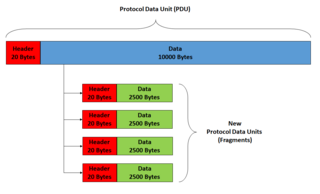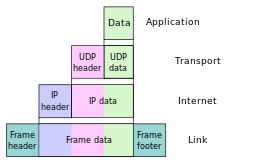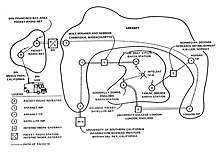Internetwork Packet Exchange (IPX) is the network layer protocol in the IPX/SPX protocol suite. IPX is derived from Xerox Network Systems' IDP. It also has the ability to act as a transport layer protocol.
The Internet Control Message Protocol (ICMP) is a supporting protocol in the Internet protocol suite. It is used by network devices, including routers, to send error messages and operational information indicating success or failure when communicating with another IP address. For example, an error is indicated when a requested service is not available or that a host or router could not be reached. ICMP differs from transport protocols such as TCP and UDP in that it is not typically used to exchange data between systems, nor is it regularly employed by end-user network applications.

Internet Protocol version 4 (IPv4) is the fourth version of the Internet Protocol (IP). It is one of the core protocols of standards-based internetworking methods in the Internet and other packet-switched networks. IPv4 was the first version deployed for production on SATNET in 1982 and on the ARPANET in January 1983. It is still used to route most Internet traffic today, even with the ongoing deployment of Internet Protocol version 6 (IPv6), its successor.

Internet Protocol version 6 (IPv6) is the most recent version of the Internet Protocol (IP), the communications protocol that provides an identification and location system for computers on networks and routes traffic across the Internet. IPv6 was developed by the Internet Engineering Task Force (IETF) to deal with the long-anticipated problem of IPv4 address exhaustion, and was intended to replace IPv4. In December 1998, IPv6 became a Draft Standard for the IETF, which subsequently ratified it as an Internet Standard on 14 July 2017.
The Internet protocol suite, commonly known as TCP/IP, is a framework for organizing the set of communication protocols used in the Internet and similar computer networks according to functional criteria. The foundational protocols in the suite are the Transmission Control Protocol (TCP), the User Datagram Protocol (UDP), and the Internet Protocol (IP). Early versions of this networking model were known as the Department of Defense (DoD) model because the research and development were funded by the United States Department of Defense through DARPA.
In computer networking, the maximum transmission unit (MTU) is the size of the largest protocol data unit (PDU) that can be communicated in a single network layer transaction. The MTU relates to, but is not identical to the maximum frame size that can be transported on the data link layer, e.g., Ethernet frame.
The Transmission Control Protocol (TCP) is one of the main protocols of the Internet protocol suite. It originated in the initial network implementation in which it complemented the Internet Protocol (IP). Therefore, the entire suite is commonly referred to as TCP/IP. TCP provides reliable, ordered, and error-checked delivery of a stream of octets (bytes) between applications running on hosts communicating via an IP network. Major internet applications such as the World Wide Web, email, remote administration, and file transfer rely on TCP, which is part of the Transport layer of the TCP/IP suite. SSL/TLS often runs on top of TCP.
In computer networking, the User Datagram Protocol (UDP) is one of the core communication protocols of the Internet protocol suite used to send messages to other hosts on an Internet Protocol (IP) network. Within an IP network, UDP does not require prior communication to set up communication channels or data paths.
In the seven-layer OSI model of computer networking, the network layer is layer 3. The network layer is responsible for packet forwarding including routing through intermediate routers.

IP fragmentation is an Internet Protocol (IP) process that breaks packets into smaller pieces (fragments), so that the resulting pieces can pass through a link with a smaller maximum transmission unit (MTU) than the original packet size. The fragments are reassembled by the receiving host.
A broadcast address is a network address used to transmit to all devices connected to a multiple-access communications network. A message sent to a broadcast address may be received by all network-attached hosts.
The maximum segment size (MSS) is a parameter of the Options field of the TCP header that specifies the largest amount of data, specified in bytes, that a computer or communications device can receive in a single TCP segment. It does not count the TCP header or the IP header. The IP datagram containing a TCP segment may be self-contained within a single packet, or it may be reconstructed from several fragmented pieces; either way, the MSS limit applies to the total amount of data contained in the final, reconstructed TCP segment.
Mobile IP is an Internet Engineering Task Force (IETF) standard communications protocol that is designed to allow mobile device users to move from one network to another while maintaining a permanent IP address. Mobile IP for IPv4 is described in IETF RFC 5944, and extensions are defined in IETF RFC 4721. Mobile IPv6, the IP mobility implementation for the next generation of the Internet Protocol, IPv6, is described in RFC 6275.
In packet-switched computer networks, a jumbogram is an internet-layer packet exceeding the standard maximum transmission unit (MTU) of the underlying network technology. In contrast, large packets for link-layer technologies are referred to as jumbo frames.
A network socket is a software structure within a network node of a computer network that serves as an endpoint for sending and receiving data across the network. The structure and properties of a socket are defined by an application programming interface (API) for the networking architecture. Sockets are created only during the lifetime of a process of an application running in the node.
6LoWPAN was a working group of the Internet Engineering Task Force (IETF). It was created with the intention of applying the Internet Protocol (IP) even to the smallest devices, enabling low-power devices with limited processing capabilities to participate in the Internet of Things.
Path MTU Discovery (PMTUD) is a standardized technique in computer networking for determining the maximum transmission unit (MTU) size on the network path between two Internet Protocol (IP) hosts, usually with the goal of avoiding IP fragmentation. PMTUD was originally intended for routers in Internet Protocol Version 4 (IPv4). However, all modern operating systems use it on endpoints. In IPv6, this function has been explicitly delegated to the end points of a communications session. As an extension to the standard path MTU discovery, a technique called Packetization Layer Path MTU Discovery works without support from ICMP.
A routing protocol specifies how routers communicate with each other to distribute information that enables them to select paths between nodes on a computer network. Routers perform the traffic directing functions on the Internet; data packets are forwarded through the networks of the internet from router to router until they reach their destination computer. Routing algorithms determine the specific choice of route. Each router has a prior knowledge only of networks attached to it directly. A routing protocol shares this information first among immediate neighbors, and then throughout the network. This way, routers gain knowledge of the topology of the network. The ability of routing protocols to dynamically adjust to changing conditions such as disabled connections and components and route data around obstructions is what gives the Internet its fault tolerance and high availability.
The internet layer is a group of internetworking methods, protocols, and specifications in the Internet protocol suite that are used to transport network packets from the originating host across network boundaries; if necessary, to the destination host specified by an IP address. The internet layer derives its name from its function facilitating internetworking, which is the concept of connecting multiple networks with each other through gateways.
An IPv6 packet is the smallest message entity exchanged using Internet Protocol version 6 (IPv6). Packets consist of control information for addressing and routing and a payload of user data. The control information in IPv6 packets is subdivided into a mandatory fixed header and optional extension headers. The payload of an IPv6 packet is typically a datagram or segment of the higher-level transport layer protocol, but may be data for an internet layer or link layer instead.





